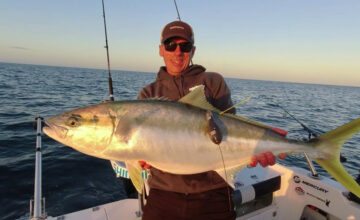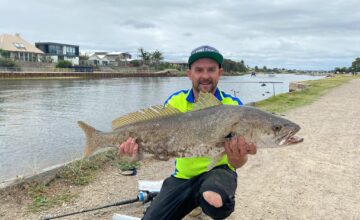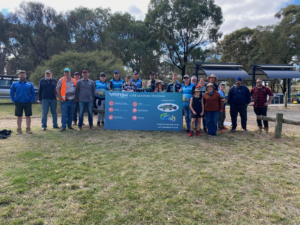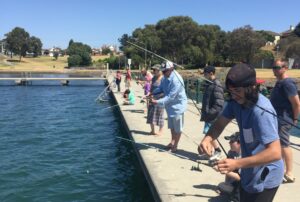October 13, 2015
By Yvette Barry, science writer for REDMAP
Australia’s seas are warming and fish are moving their homes further south than usual.
Last summer Paul Sorensen spotted a tropical-looking fish lingering in an abandoned shopping trolley under Frankston Pier, south-east of Melbourne. Paul took a photo of the 40cm blue- spotted and white-striped fish but didn’t know what it was until he scrolled the internet. Turns out it was a blue-spotted coral trout (Plectropomus laevis): a species far away from its usual home in tropical Queensland waters.
“It then became our little Frankston Pier icon,” Paul says. “It hung around the pier for four weeks.”
The coral trout either hitched a ride south on the East Australian Current or was dumped from a salt water aquarium. Paul noted it had lesions on the tail fin and it did not survive long.
Although this coral trout was an unusual tropical visitor, marine biologist Gretta Pecl expects Victorian fishers will catch more and more warm-water fish if sea temperatures continue to rise. Gretta is an Associate Professor at the University of Tasmania’s Institute for Marine and Antarctic Studies.
“The world’s climate is changing,” says Gretta, “and oceans are absorbing more than 80 per cent of the extra heat generated by global warming.”
Gretta says Australia’s east coast, in particular, is considered an ocean warming ‘hotspot’ where average sea surface temperatures increased 2.28 degrees Celsius over the last 100 years.
A few degrees plus or minus doesn’t sound like much. But for marine life it can mean the difference between thriving and barely surviving. That’s because each marine animal and plant species prefers its own unique range of water temperatures, salinity, depth and habitat (among other aspects). Such factors determine where a fish lives and how it responds to ocean warming.
“Some marine species are able to adapt to these new conditions,” Gretta says. “Some cannot thrive in warmer waters and so the population may slowly die out. Others will follow their preferred water temperature southwards in order to survive.”
Studies on whole ecosystems suggest more than 25 per cent of the world’s species have already shifted their postcodes toward the poles in response to rising temperatures.
The shift in fish distribution is most obvious into Tasmanian waters. Fishers have been telling Gretta for years that species common in Victorian seas – like King George whiting, eastern rock lobster and snapper – are being caught more frequently and much further south than usual along Tasmania’s east coast.
Tasmanian fisherman Johah Yick has been throwing in lines for 21 years. Yet he only caught his first yellowtail kingfish earlier this year – and as far south as Hobart. Kingfish (Seriola lalandi) is common in Victoria but the species is, historically, a rare visitor across the Tasman.
Last summer Jonah started spotting schools of 50-plus hoodlums* near Hobart. After tweaking his technique he finally snagged five kingfish. His tips? “Cast soft plastic lures to the surface of a feeding school, as well as on weighted or un-weighted squid strips.”
(*Kingfish tend to fight dirty at the end of the line, hence their nicknames hoodlum and bandit).
“This was pretty exciting for me as it was one of those fish I had always wanted to ‘tick off’ in Tasmanian waters,” Jonah says.
It’s common for fish to be carried down to Victoria and Tasmania on the East Australian Current in the summer, only to die out or retreat in the cooler months. But this pattern is changing with the combination of warmer year-round temperatures and a strengthening East Australian Current. The EAC now reaches 350km further south along eastern Tasmania compared to the 1940s.
Does this mean Victoria’s usual catches will venture south more permanently to be replaced by warmer-water fish from New South Wales and Queensland?
It’s a question Gretta and her team are asking Australians like Paul and Jonah, with their unusual marine observations, to help answer.
REDMAP.ORG.AU invites the public to become citizen scientists and record sightings of new or uncommon marine life that turn up in their local seas.
Both Paul and Jonah logged their uncommon sightings on the Redmap app. Their photos were verified by one of Redmap’s 80 marine scientists who confirmed the species identification and display the sighting online. Your secret fishing spots are safe, though, as sighting location maps are only shown at a resolution of 50km!
Community observations help scientists to reveal patterns in the movement of fish into new regions. Given Australia’s 60,000 kilometres of coastline, and the usual research funding constraints, scientists welcome this citizen science data.
“Thousands of fishers are on the water all the time and often see changes in Australia’s oceans before scientists do,’ Gretta says. ‘Redmap taps into the local knowledge of fishers. Their observations allow Redmap to better understand changes in the distributions of marine life.’
Redmap is also interested in marine animals that science knows little about. This includes turtles, whales, jellyfish, rays and sharks, to name a few.
Redmap member Robbie Waller uploaded a photo of a green turtle (Chelonia mydas) near Phillip Island. Robbie noted the large turtle had limpets and green algae attached to its head and shell.
“I’d be happy to put up with both if I can make it to the same age!” Robbie told Redmap.
Green turtles are found all around Australia but Redmap is interested in all sightings as turtle distribution and movement patterns are currently not well known.
Redmap citizen scientists have shared more than 1500 sightings and photos on Redmap. Over time, the community observations will be an early indication of those fish or regions that are most impacted by ocean warming. Traditional research can then be focused on marine animals more likely to be shifting their homes south.
Studying Australia’s fish distributions, and how fish are likely to respond to warming seas, helps to prepare recreational and commercial fishers for possible changes in the fish they catch in their local seas in the near-future.
How you can help REDMAP
The Range Extension Database and Mappingproject invites fishers and divers to log marine life not usually found in their local seas. Download the Redmap app or visit www.redmap.org.auto share your photos of uncommon fish. Each sighting is verified by a marine scientist and displayed on the website. Follow us on facebook.com/RedmapAustralia. Redmap is hosted by the Institute for Marine and Antarctic Studies (IMAS) at the University of Tasmania.
Top 3 most logged marine life on Redmap in Victoria since 2012:
- Western blue groper (Achoerodus gouldii)
- White-ear (Parma microlepis)
- Whitebarred boxfish (Anoplocapros lenticularis)
Paul Sorensen noticed a blue-spotted coral trout hanging out at the Frankston Pier for weeks. This species usually lives in tropical seas in Queensland and northern Australia. (Photo: Paul Sorensen)
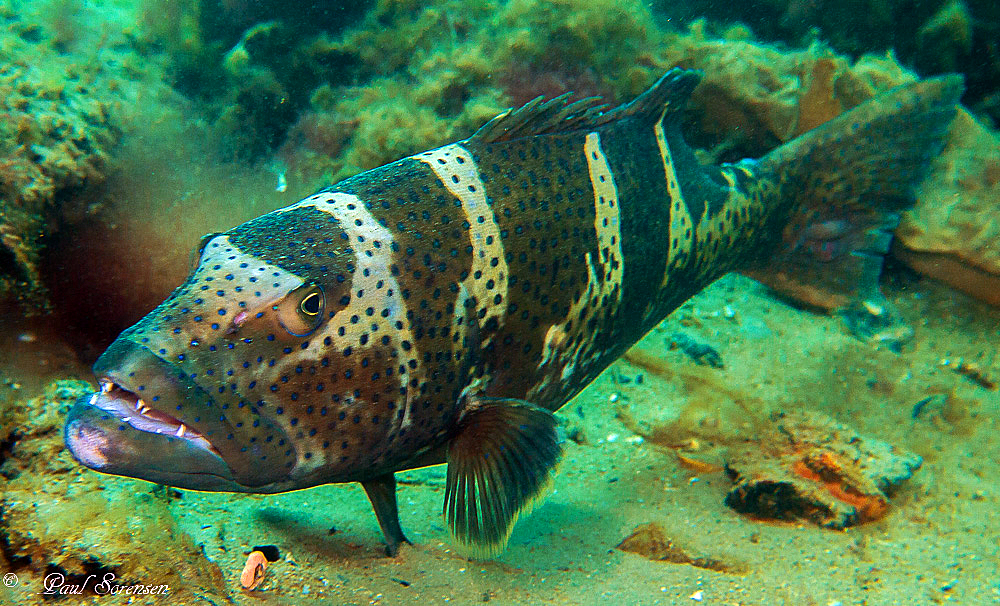
Robbie Waller spotted this green turtle near Phillip Island. Redmap is interested in all turtle sightings so we can better understand their distribution around Australia. (Photo: Robbie Waller)

Another unusual sighting on Redmap: a giant squid near Orbost. Note how large this squid is compared to the fishing rod! Giant squid (Architeuthis), which may reach up to 15 metres in total length, dwell in the deep sea and are rarely seen around the world. This Redmap sighting is also exciting and important as little is known of this squid’s distribution. (Photo: Craig Mills).



